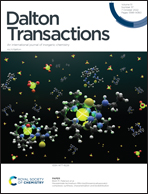The electrostatic confinement of aquated monocationic Gd(iii) complex-molecules within the inner core of porous silica nanoparticles creates a highly efficient T1 contrast agent for magnetic resonance imaging†
Abstract
Contrast-agent enhanced magnetic resonance imaging (MRI) has been under continuous investigation for the conspicuous imaging of lesions and the early-stage detection of tumors. To achieve the development of a T1-weighted contrast agent with a high relaxivity value, herein, porous silica nanoparticles that had internalized about 20 aquated cationic Gd(III) complexes (1) of the hexadentate hydroxyethyl-appended picolinate-based ligand H2hbda were demonstrated. Complex 1 exhibited a longitudinal relaxivity value per mM Gd(III) ions, r1, of 9.05 mM−1 s−1 (pH 7.4, 37 °C, 1.41 T), which increased to 86.41 mM−1 s−1 because of the grafting of complex 1 in the inner core of porous silica nanospheres through electrostatic interactions between the anionic silica surface and the cationic complex 1 molecules. A further augmentation in the relaxivity value to 118.32 mM−1 s−1 was realized because of the interaction of the complex 1@SiO2NPs with serum albumin protein. The synthesized nanosystem was impervious to physiologically available anions (HPO42− and HCO31−) and also kinetically inert, as evidenced via a transmetallation experiment in the presence of Zn(II) ions. The developed complex-incorporated nanomaterial was bio- and hemo-compatible. Cellular uptake measurements employing HeLa cells and the concentration-dependent enhancement in the brightness of in vitro phantom images, recorded under a clinical scanner at 1.5 T, demonstrated that the developed biocompatible 1@SiO2NP complex has promising diagnostic applications as a T1-weighted MRI contrast agent.



 Please wait while we load your content...
Please wait while we load your content...